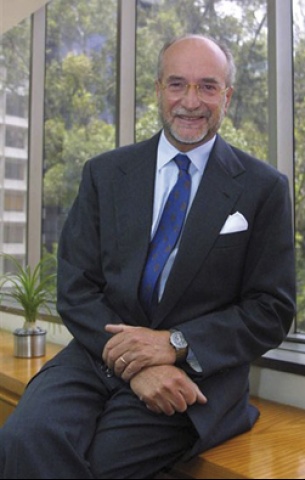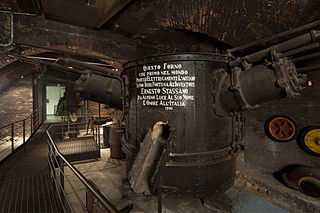
SS Conte Biancamano was an Italian ocean liner launched in 1925. The name was chosen in honor of Humbert I Biancamano, founder of the Savoy dynasty. She was built in the Scottish shipyard William Beardmore & Co. in Dalmuir, near Glasgow. She was built for the Genovese shipping company Lloyd Sabaudo, operator of Conte Rosso and Conte Verde. The engine, equipped with two steam turbines double reduction unit and two propellers, allowed her to reach a speed of 20 knots, and vented in two funnels. She housed 180 passengers in first class, 220 in second class, 390 in economic class and 2,660 in third class.

Museo Nazionale Scienza e Tecnologia Leonardo da Vinci in Milan, dedicated to painter and scientist Leonardo da Vinci, is the largest science and technology museum in Italy. It was opened on 5 February 1953 and inaugurated by Prime Minister Alcide De Gasperi.

The FS Class E.550 was a class of three-phase electric locomotive used in Italy, introduced in the 20th century, which remained in service until 1965.

Gianfelice Mario Rocca is an Italian billionaire businessman. He is chairman of the Techint Group and Istituto Clinico Humanitas.

Paul Biddle is an English fine art photographer, who specialises in creating carefully studied surreal artworks using real objects and studio lighting for artistic effects. He has exhibited widely both in Britain and around the world. He has won at least 15 international photography prizes.

The church and monastery of San Vittore al Corpo were an ancient monastery of the Olivetan order built in the early 16th century. The site was once a fourth century Roman imperial mausoleum of Maximian, that may also have held the burials of the emperors Gratian and Valentinian II, though they were more likely buried in another mausoleum, now the Chapel of Saint Aquilinus in the Basilica of Saint Lawrence. The basilica was enlarged in the 8th century to house the relics of the saints Vittore and Satiro. A Benedictine monastery soon was attached to the church. In 1507, the monastery was transferred to the Olivetans, who began a major reconstruction. Reconstruction of the church was begun in 1533 by Vincenzo Seregni, and completed in 1568 by Pellegrino Tibaldi. The façade remains incomplete. The dome was frescoed in 1617 by Guglielmo Caccia. In the chapel of St Anthony is a 1619 canvas by Daniele Crespi. In the transept on the left, is an early 17th-century cycle of canvases of the Stories of San Benedetto, by Ambrogio Figino while the right transept has three altarpieces by Camillo Procaccini. Other chapels have paintings by Pompeo Batoni and Giovanni Battista Discepoli.

The Icaro Stratos is an Italian high-wing, single-place, rigid-wing hang glider that was designed by Icaro 2000 in conjunction with A-I-R GmbH and Felix Ruhle and produced by Icaro 2000, of Sangiano, circa 2003.

Giuseppe Mazza was an Italian painter active in a Romantic style.
Paolo Galluzzi is an Italian historian of science.

Italian submarine Enrico Toti was the first of a new class of Italian submarine (Toti-class), with the S 506 Enrico Toti being laid down in 1965, launched in 1967, decommissioned in 1992 and preserved as a museum ship in Museo della Scienza e della Tecnologia "Leonardo da Vinci", in Milan. The ship, and class, are named after the Italian war hero Enrico Toti.

Franca Helg was an Italian designer and architect. She also had a career teaching at Istituto Universitario Architettura Venezia and Polytechnic of Milan. She collaborated with Franco Albini from 1945 through 1977.

The Ferrovie dello Stato Italiane Class 552, formerly Rete Adriatica Class 180 bis, is a 4-4-0 steam locomotive; it was the final development in Italy of the 'American' express locomotive type.

The Ferrovie dello Stato Italiane Class 835 is a 0-6-0T steam locomotive; it was the standard steam shunter of the FS.

The Stassano furnace is an electric arc furnace for the production of steel. Invented by Ernesto Stassano in 1898, it is the first electric furnace in history for ferrous metallurgy.

Ebe is a former training ship of the Italian Navy. Initially a merchant vessel named San Giorgio, she was acquired by the Navy and used to train non-commissioned officers between 1952 and 1958. Since 1963 she has been preserved and exhibited at the Museo Nazionale Scienza e Tecnologia Leonardo da Vinci in Milan.

The FS Class E.430 locomotives, initially classed as RA 34, were three-phase alternating current electric locomotives of the Italian railways. They were built for Ferrovia della Valtellina by Ganz and MÁVAG in 1901 and had a power output of 440 kW and a haulage capacity of 300 tons. One locomotive is preserved.

The Museo Leonardiano di Vinci, or Leonardian Museum of Vinci, is a museum dedicated to Leonardo da Vinci, located in Vinci, Leonardo's birthplace, in the province of Florence, Italy.

















